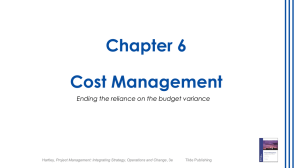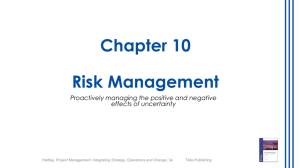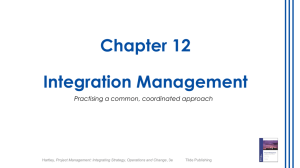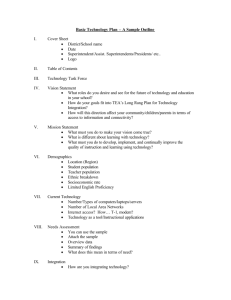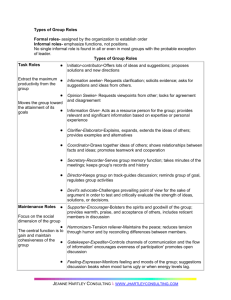Tb-Hartley-ProjectManagement3e-Ch5-PPTs
advertisement
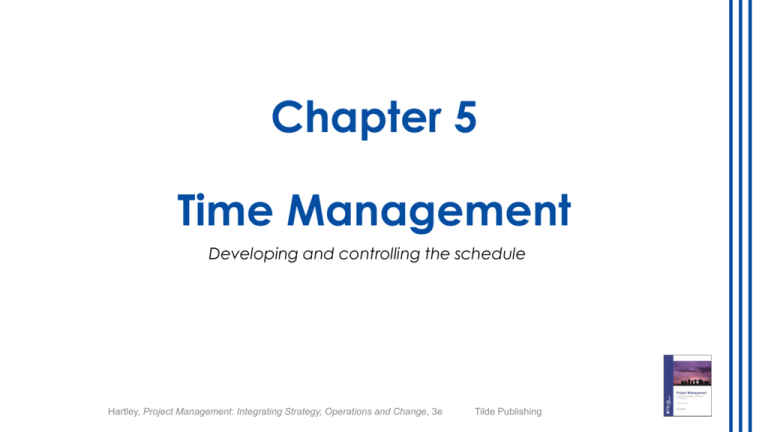
Chapter 5 Time Management Developing and controlling the schedule Hartley, Project Management: Integrating Strategy, Operations and Change, 3e Tilde Publishing Chapter overview 1. 2. 3. 4. 5. 6. 7. 8. Planning schedule management Defining activities Estimating durations Identifying the resource capability Experimenting with the sequence Developing the schedule Working with the critical path Controlling the schedule © 2014 Hartley, Project Management: Integrating Strategy, Operations and Change, 3e Tilde Publishing 2 Planning schedule management a document that will guide and direct how the project schedule is ultimately managed throughout the project The plan may include reference to: o the rationale for managing the schedule o any perceived obstacles or constraints impacting o appropriate control thresholds triggering an intervention o timing and format of schedule reports (against the plan) o processes required to update the schedule o project management software for developing the schedule o preferred tools to be used (e.g. WBS, milestones, Gantt Chart) o estimating techniques o change control procedures o rules in calculating percent complete o definitions of actual performance measurement © 2014 Hartley, Project Management: Integrating Strategy, Operations and Change, 3e Tilde Publishing 3 Defining activities Verb-noun descriptor (e.g. write report) Unique identifier (WBS number) Activity time (duration v/s effort) Logical relationships (predecessor and successor) Resource requirements Constraints and/or assumptions Required standards © 2014 Hartley, Project Management: Integrating Strategy, Operations and Change, 3e Tilde Publishing 4 Estimating durations Pre-determined Expert judgement Analogous Group decision making Unit rates Published commercial data Parametric Vendor bid Reserve 3 point © 2014 Hartley, Project Management: Integrating Strategy, Operations and Change, 3e Tilde Publishing 5 Identifying the resource capability Consider the following suggestions (easily recorded in a resource matrix): Resource name—individual name or generic label (e.g. plumbers) Resource type—labour, material,… Resource group—the group to whom the resource belongs Resource capability—skills, expertise, prior experience, … Resource rate—what is their normal rate, or other fixed/variable costs Resource location—the physical (geographical) location Resource quantity—how many will be required Resource availability—the actual ‘free’ time they have to allocate Resource calendar—what dates are excluded throughout the project Resource report—who does the resource currently report to Resource development—will any additional training be required Resource evaluation—performance evaluations from past projects © 2014 Hartley, Project Management: Integrating Strategy, Operations and Change, 3e Tilde Publishing 6 Experimenting with the sequence The development of the project schedule is driven by these activity-to-activity relationships in determining when activities start and finish. Finish – Start: one activity finishes to start the other activity Start – Start: one activity starts to start the other activity Finish – Finish: one activity finishes to finish the other activity Start – Finish: one activity starts to finish the other activity © 2014 Hartley, Project Management: Integrating Strategy, Operations and Change, 3e Tilde Publishing 7 Developing the schedule A work breakdown structure is not a schedule Network diagrams and/or Gantt charts create schedules Schedule activities to start as-soon-as-possible Activities can be sequenced in–series or in parallel Milestones signify significant points in time (zero duration) Relationships may be mandatory, others discretionary Schedules often represent intent; not necessarily reality unless they are updated regularly Work backwards to try and eliminate errors and time © 2014 Hartley, Project Management: Integrating Strategy, Operations and Change, 3e Tilde Publishing 8 Working with the critical path The longest path(s) throughout the schedule (activities on this path represent the longest duration scheduled for the project’s completion) The path(s) or activities(s) with zero float (meaning nothing can be delayed) The activities(s) or milestone driving the end date of the project The shortest completion time of the project (where the project cannot be completed in any less time within the current schedule). © 2014 Hartley, Project Management: Integrating Strategy, Operations and Change, 3e Tilde Publishing 9 Controlling the schedule To effectively control the project schedule, the following actions should be considered: updating changes to the schedule as they occur determining the current reporting date of the project assessing the current status of the project against the published plan to identify true performance re-scheduling remaining activities re-circulating the agreed schedule revision conducting retrospective reviews and walkthroughs to record lessons learned © 2014 Hartley, Project Management: Integrating Strategy, Operations and Change, 3e Tilde Publishing 10 Review questions 1. What is the value behind having a schedule management plan? 2. What information does a work breakdown structure capture and how does this help scheduling? 3. Activity duration and resource estimates are often not precise calculations. What techniques are available and how would you defend your choice of technique? 4. What is the difference between critical path and critical chain methods? 5. Explain why project schedules have to be developed, tracked, reported and controlled throughout the project? © 2014 Hartley, Project Management: Integrating Strategy, Operations and Change, 3e Tilde Publishing 11 Group learning activities Discuss the rationale for having to manage and control the schedule Compare and contrast different estimation techniques for their accuracy Provide examples of mandatory and discretionary relationship types Debate the notion of scheduling work to start as soon as possible Discuss how a Gantt chart is both a planning and managing tool Discuss why schedule intent seldom reflects reality (prior to it being updated) © 2014 Hartley, Project Management: Integrating Strategy, Operations and Change, 3e Tilde Publishing 12 Assessment options Debate where the focus should lie - critical path or critical chain Create a detail resource matrix capturing the capability required for a project Construct a Gantt chart to scale of a project reflecting a WBS, activities, milestones, relationship types and critical path Short answer questions Multiple choice questions © 2014 Hartley, Project Management: Integrating Strategy, Operations and Change, 3e Tilde Publishing 13
